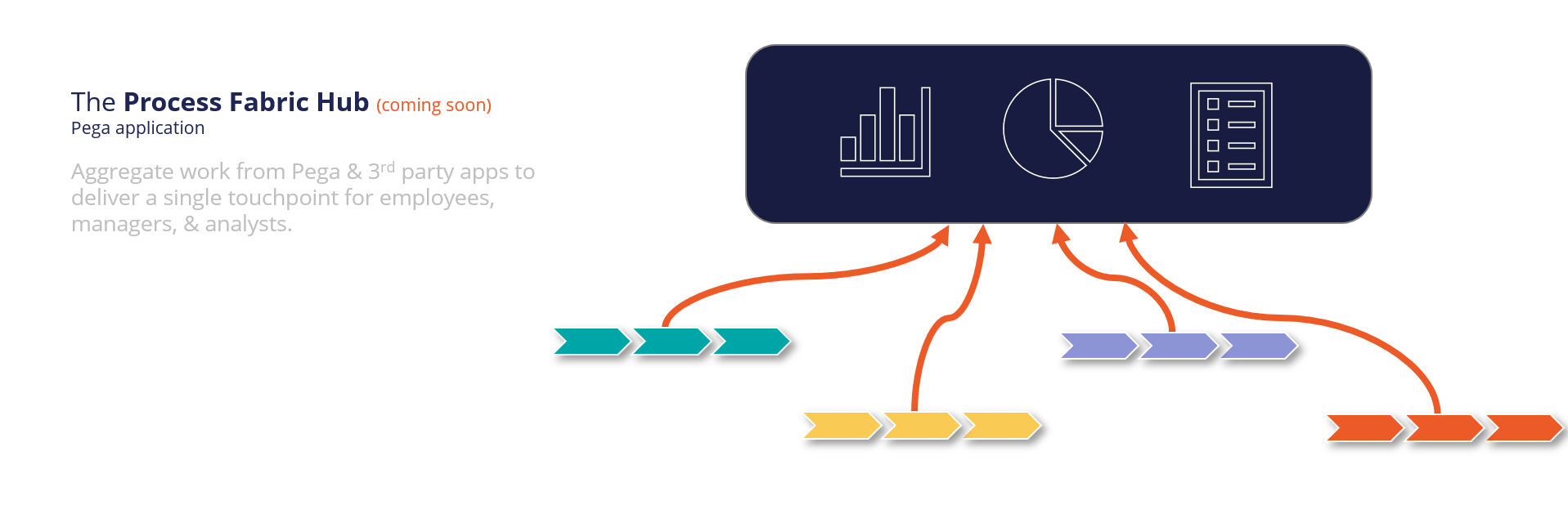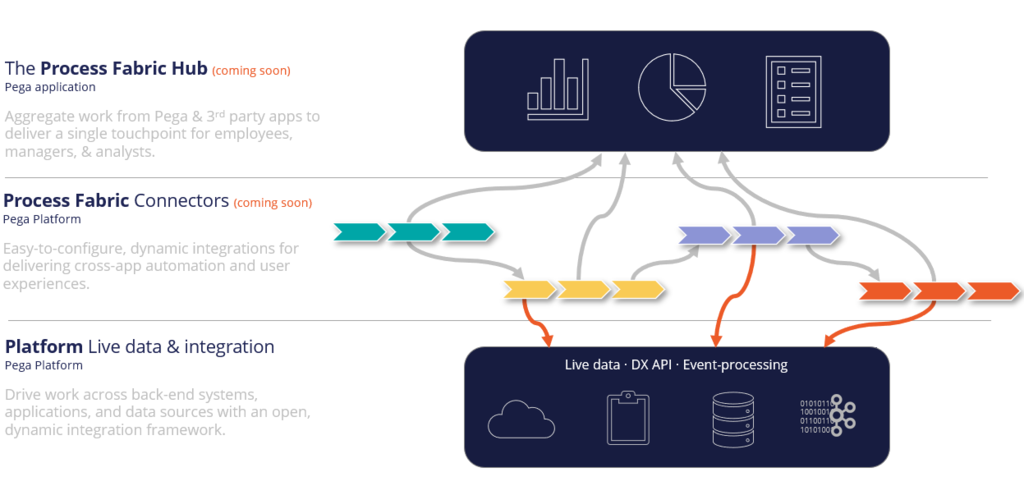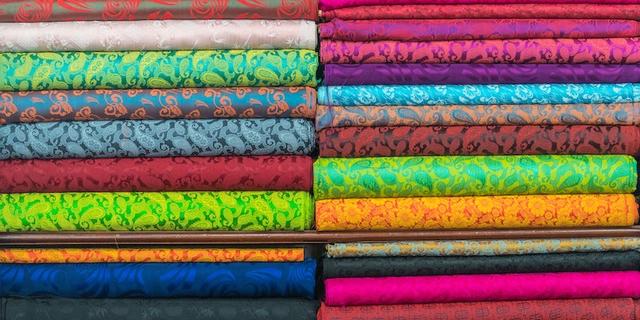If you're reading this, you probably know that at PegaWorld 2020, we introduced what we're calling Pega Process Fabric® - describing it as "a strong, flexible Center-out™ business architecture weaves together business processes, case management, and workflow – across all systems and platforms."
We knew immediately that this message resonated... but what exactly is Pega Process Fabric? Is it something you can hold & feel? or is it just a state-of-mind - something achieved after a long, isolated retreat to the woods?
You'll be pleased to hear that Process Fabric is very real, and is going to give Pega application developers powerful new capabilities for streamlining the customer experiences and improving employee productivity. Let's see how.
The problem: IT application landscapes have grown apart
Large organizations have 100's if not 1000's of unique, independent business applications in their IT landscapes - and 'uniformity' is not exactly a word you could apply to most of them. Some apps are old, some are new, some are built-from-scratch, some are built-on Low code platforms like Pega, and some are more out-of-the-box SaaS solutions.
And a single customer journey inevitably cuts across any number of these independent applications... leaving open massive doors for:
- Delays & friction as employees hop across multiple applications to get things done.
- Data silos due to lack of integration which hinders decision making and a consistent customer experience.
- Duplication of work as siloed development teams work to solve the same problem in multiple applications.
These are the problems Pega Process Fabric® solves.
At a high level, Pega Process Fabric® provides a thin layer of capabilities to facilitate:
- Cross-application visibility
- End-to-end process orchestration
- and dynamic application integration
Let's dive into each of these in a bit more details to understand the powerful capabilities which can help you create a Process Fabric in your organization.
1. Cross-application visibility
As the number of business applications in your organization scales, data, work and assignments become more and more scattered which can massively impact your team:
- Employees need to alt-tab between dozens of applications to get a sense of all of their work, complete tasks, and understand which assignments they should be prioritizing first.
- Managers need custom spreadsheets and reports to build a 360° view of customers and end-to-end processes.
- Developers build custom integrations and solutions to try and fill these gaps.
This is why we are introducing our first new Process Fabric capability – the Process Fabric Hub.

The Process Fabric Hub will let organizations register applications across their enterprise, both Pega and non-Pega to aggregate work and assignments to do a few things:
- For employees: provide a single portal to interact with multiple apps. The first feature we’re focused on here is what we’re calling the Interwoven Worklist, which will provide a unified, prioritized worklist and the ability to perform Get Next Work with assignments from multiple apps.
- For managers: The Process Fabric Hub will also be key in delivering better insights – providing out-of-the-box reports and ability to slice and dice data from across applications - making it easy to do things like report on all of the open and recently completed assignments across apps for a single customer.
- For developers: Simple registration and pre-built connectors - so keeping up with an ever-evolving landscape of apps is simple.
The Process Fabric Hub will be available for use soon, with an upcoming release. To see a demo, prepare, and learn more, check out our Tech Talk on Pega Community.
2. End-to-end process orchestration
Another massive pain point for IT teams is integrating business applications to automate end-to-end processes across systems. Hard-coded integrations with custom interfaces are costly to develop and notoriously fragile - prone to issues as processes and applications evolve.
That's why we are also introducing new capabilities in the Platform focused on making it easy to connect microjourneys between applications without embedding logic in hard-coded integrations and interfaces. If you’ve been with Pega for a while, you may have heard of Federated Case Management and this is really the evolution of that capability - leveraging microservices and the Digital Experience (DX) API.
Our first capabilities here are focused on making Pega-to-Pega application UX integrations super simple and future-proof.
Let’s say you want to embed a worklist or a case creation form from one app into another? Where today you’d be developing custom sections, with hard coded API calls - tomorrow we’re bringing it all into App Studio into a new capability called remote case types which will make the integrations configurable in a few clicks. Behind the scenes, the UX - including fields, layout, and data - will be driven from the external system in real-time with the DX API; ensuring integrations are future-proof.
Remote case types will be available in the Pega Platform soon, in an upcoming release.

3. Dynamic application integration
Beyond the new Pega Process Fabric capabilities, the continually evolving data and integration capabilities in the Pega Platform are pivotal in making Process Fabric a reality. Within a microjourney, it is crucial to provide employees, managers, and customers the data that they need in order to get work done, when they need it.
That's why no Process Fabric can be complete without leveraging our suite of powerful data and integration capabilities:
- Open integrations to access data in external systems through any protocol you need (including Robotic Process Automation to access legacy systems which don't have modern API's).
- Live data to manage, simulate, and virtualize data objects; ensuring data is always available and never stale.
- Event processing to connect your application to streaming data and messages (through JMS, Apache Kafka, and more).

Getting started
So now that you know Pega Process Fabric is real, you're probably itching to get started weaving together processes across systems and platforms.
The good news is, you can start today. Here are a few ways you can begin to build a Process Fabric in your organization:
- Familiarize yourself with the Pega Platform's powerful suite of Data & integration capabilities.
- Start building your App Factory to efficiently scale low-code in your organization.
- Check out a demo and learn more about what's coming in the Process Fabric Hub.
Don't Forget
- JOIN THE CONVERSATION on Collaboration Center
- FOLLOW @PegaDeveloper on Twitter
- SUBSCRIBE to the Pega Developer Podcast on Spotify or via RSS

